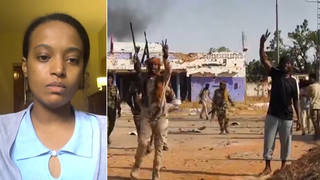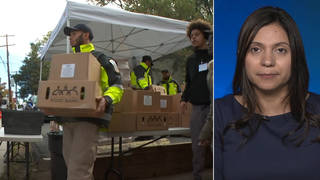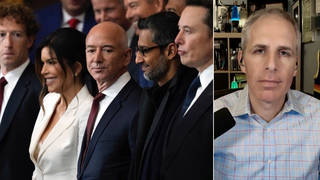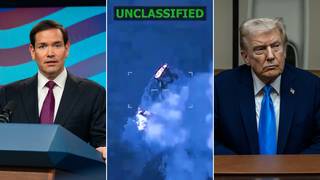
Guests
- Nathan Phillipsan Omaha elder who participated in the Indigenous Peoples March on Friday. A video showing high school students appearing to mock him has gone viral. Phillips is a Vietnam-era veteran and previous director of the Native Youth Alliance.
On Friday, thousands took part in the Indigenous Peoples March in Washington, D.C. The next day, video went viral of an interaction that took place soon after the march ended between an indigenous elder and a group of Catholic high school students from Kentucky who had attended a March for Life protest the same day. In the video, Omaha elder Nathan Phillips is seen peacefully playing his drum and singing while being encircled by the students—some of whom were wearing red “Make America Great Again” hats. The video appears to show the students taunting and mocking Phillips. Some of the students are seen making a tomahawk-chop motion with their arms. One student wearing a red MAGA hat is seen standing directly in front of Phillips while grinning and smirking. The videos sparked widespread outrage, but some commentators walked back their critique of the students after more videos were posted online. We speak to Nathan Phillips about what happened. He is a Vietnam-era veteran and previous director of the Native Youth Alliance.
More from this Interview
- Part 1: “I Was Absolutely Afraid”: Indigenous Elder on “Mob Mentality” of MAGA Hat-Wearing Students in D.C.
- Part 2: Chase Iron Eyes: Trump’s Mocking of Native Americans Gives License to Others to Denigrate My People
- Part 3: “The Heartbeat of Wounded Knee”: David Treuer on Retelling Native American History
Transcript
JUAN GONZÁLEZ: We turn now to a story that received widespread attention over the weekend. On Friday, thousands took part in the Indigenous Peoples March in Washington, D.C. The next day, video went viral of an interaction that took place soon after the march ended between an indigenous elder and a group of Catholic high school students from Kentucky who had attended a March for Life protest the same day.
AMY GOODMAN: In the video, Omaha elder Nathan Phillips is seen peacefully playing his drum and singing, while being encircled by the students, some of whom were wearing red MAGA hats—”Make America Great Again.” The video appears to show the students taunting and mocking Phillips. Some of the students are seen making a tomahawk-chop motion with their arms.
JUAN GONZÁLEZ: One student, wearing a red MAGA hat, is seen standing directly in front of Phillips while grinning and smirking. The video sparked widespread outrage. After the video went viral Saturday, the Catholic Conference of Kentucky condemned the students’ actions, saying, quote, “This behavior is opposed to the Church’s teachings on the dignity and respect of the human person.” Newly elected Native American Congresswoman Deb Haaland tweeted, quote, “The students’ display of blatant hate, disrespect, and intolerance is a signal of how common decency has decayed under this administration. Heartbreaking.”
But the story didn’t end after the first video went viral on Saturday. As the weekend progressed, more videos were posted online showing a fuller picture of what happened. It was Nathan Phillips who first approached the students in an attempt to defuse a tense situation between the students and a small group of Black Hebrew Israelites, who were screaming offensive statements at the group of students.
AMY GOODMAN: The videos show Nathan Phillips was soon encircled by students after he approached them and was drumming. Another participant in the Indigenous Peoples March, Hunter Hooligan, wrote, quote, “We were surrounded by the boys, and we were alarmingly outnumbered. As we attempted to continue our path and move through the crowd, the boys closed in around us, until finally, one particular boy stood in front of Nathan and refused to let us pass,” unquote. According to Hunter Hooligan, some of the students were also chanting “Build the Wall.”
The student who faced off with Phillips, a high school junior named Nick Sandmann, said he, too, was trying to defuse a tense situation. Sandmann released a statement by a PR firm. It said, in part, quote, “I believed that by remaining motionless and calm, I was helping to diffuse the situation. I said a silent prayer that the situation would not get out of hand.” The statement went on to read, quote, “I was not intentionally making faces at the protestor. I did smile at one point because I wanted him to know that I was not going to become angry, intimidated or be provoked into a larger confrontation,” unquote.
The incident has sparked widespread debate on how the media handled the story. Some media commentators apologized for criticizing the students. Even President Trump weighed in, tweeting, quote, “Looking like Nick Sandman & Covington Catholic students were treated unfairly with early judgements proving out to be false–smeared by media. Not good, but making big comeback!” Trump then quoted Tucker Carlson saying, quote, “New footage shows that media was wrong about teen’s encounter with Native American,” unquote.
But others continued to criticize the actions of the students. Deadspin published an article titled “Don’t Doubt What You Saw with Your Own Eyes.” New York Times columnist Michelle Goldberg tweeted that Deadspin piece, saying, “[H]ere the rush to disavow was itself a kind of mob reaction.”
Well, we’re joined right now by Nathan Phillips, the Omaha elder who participated in the Indigenous Peoples March on Friday. Nathan Phillips is a Vietnam-era veteran and previous director of the Native Youth Alliance.
Welcome to Democracy Now!, Nathan. Thank you for staying in Washington to talk to us. Can you start off by telling us—just lay out for us what happened on Friday. The march had broken up. You were on the steps of the Lincoln Memorial, is that right? And then tell us what you saw.
NATHAN PHILLIPS: Yes, that is right. At the end of the Indigenous Peoples March, we had already been encountered with the Black Israelites. They showed up around 1:00, 2:00 in the afternoon, while we were still in our process of our rally on the steps. And they were hurling all kinds of insults and abuses at us, the indigenous people. But what I seen was, in one of the videos, is that one of the indigenous peoples did go up to them, visit with them and then turn around and walk away.
And then, when the youth that were, you know, done with the march, the protest that they were at, started coming through to go meet their bus, encountered the same Black Israelites and took a different route, and instead of responding to hate with love, they responded to hate with hate. We thought, there at the march, that the best thing to do was to ignore the Black Israelites the best we could and to pray for them or for their actions there on the Mall. We really didn’t understand their presence there and harassing us, but we just went ahead on with our rally.
Then things started escalating between the Black Israelites and the youth. The youth kept on encountering them, going away, coming back, encountering them again. And each time they came back, they came back with larger numbers, until the—until where it shows where the video is, where there’s, you know, close to 200 of those young youth out there. And they got into a mob mentality. That’s what a lot of other people have described it as.
JUAN GONZÁLEZ: And, Nathan Phillips—
NATHAN PHILLIPS: Standing on the side—yes.
JUAN GONZÁLEZ: Nathan Phillips, the Black Israelites—you’re saying that there were, at some point, as many as 200 of the youths from Kentucky. The size of the group of the Black Israelites that you saw, and also why you decided then to try to come between them?
NATHAN PHILLIPS: When it got to about 200 youth, and the screaming and the hollerings, and the images were the same images that I seen in pictures of youth, young white people, surrounding a black youth trying to eat at a counter—the same faces that were on the crowds of those youth at the D.C. was the same faces of the youth that were surrounding the young black woman who was trying to get an education. And the scorns and the scowls that were on the pictures there, the same pictures of when you see pictures of lynchings, the same faces on the folks that were doing the lynchings, that’s what these young people’s faces looked like. They were angry. They were—they got to a point where it was—it was scary.
Some folks came up to me—some of our young indigenous folks came up to me and said, “We’ve got to do something.” And when they said that, my first thought is that this isn’t our fight, this ain’t our business. You know, we’re here with a permit to do our event.
But as things started getting worse and worse, there was a group that I found out last night that the mocking chant that they were doing, apparently, was supposed to be a haka. When I seen them out there doing that, that didn’t look like no haka, but that’s beside the point. The point is that the young man who led that was Mr. Sandmann. He asked his teacher, “Can I lead this? Can I drown out those people?”
And there was always only about four of those Black Israelites. They never got any larger; they got no smaller. But they didn’t ever change their rhetoric, you know? But this is America—freedom of speech, freedom of assembly and freedom of religion. And that’s what those Black Israelites were doing, just the same way as the—
AMY GOODMAN: So, talk—Nathan, can you talk about what happened then, as you came over and started drumming, you said, to defuse the situation? And now you know this young man named Sandmann, standing in front of you, and the group of students behind them—talk about what you did there, the song you chose to sing, how you felt about the students who were there, about how close you were to this young student.
NATHAN PHILLIPS: When I was asked to help defuse this moment, I picked up the drum. It’s a drum of—instrument of prayer. And so I took that drum and started hitting it and started singing a song known as the American Indian Movement song. It’s a song of unity. It’s a song of honor and respect and prayer. And that’s why I chose that song, is to bring unity between what I seen happening to the fabric of America, the racism, the bigotry. And as I sang, I was going to just stand at the side, but I was putting myself in prayer at that time. Just before I started that song, my prayer was “God, help me. Witness what’s going on here, God. Protect us.” And then, when I made that prayer—
AMY GOODMAN: Why did you say, “God, help me”? Were you afraid?
NATHAN PHILLIPS: I was absolutely afraid. There was a group of over 200 young angry white men who were displaying mob mentality. And they were facing down just four black individuals. And it was coming to a point where just a snap of the finger could have caused them kids to descend on those four individuals. I didn’t agree with the Black Israelites and what they were saying. But what I do believe is that America is a land of freedoms. And as much as I disagreed with those Black Israelites, they had the right to be there.
JUAN GONZÁLEZ: And, Nathan Phillips, the young man who was staring you down, did he at any time say anything to you? Because it’s obvious that the youths in the background are either making catcalls or yelling, but he’s standing there silently. Do you recall what were some of the catcalls that were coming, being directed at you by the other youths in the back?
NATHAN PHILLIPS: Some of the things that were said, I just don’t want to repeat. But there were comments of “build that wall.” And I’ve heard these comments so many times in my years that I’ve just gotten to a point where I ignore the words that come at me, you know, the derogatory words—excuse me.
And so, when we were there and we came face to face with Mr. Sandmann, right before that, when it shows me walking towards the group, the group started spreading apart. And that was the moment when we thought we was going to try to be out of that situation, and I was going to take my people out of that situation, and I seen a higher ground behind them, the Lincoln Memorial. And as I was in the process and he’s there, my mind is that I’m in prayer. You know, this is where my thought is, that I’m not thinking of anything else other than staying in prayer and staying with the thought that I want God to come witness what’s happening into my America, you know, the racism that’s happening.
AMY GOODMAN: Nathan, I wanted to read—
NATHAN PHILLIPS: And that’s what was happening.
AMY GOODMAN: I wanted to read the statement of Nick Sandmann—
NATHAN PHILLIPS: Yes.
AMY GOODMAN: —the Covington high school student, whose PR firm wrote, “The protestor everyone has seen in the video began playing his drum as he waded into the crowd … He locked eyes with me and approached me, coming within inches of my face. He played his drum the entire time he was in my face. I never interacted with this protestor. I did not speak to him. I did not make any hand gestures or other aggressive moves. … I believed that by remaining motionless and calm, I was helping to diffuse the situation.” Your response?
NATHAN PHILLIPS: Copycat? You know, because that’s the first thing—the first interview I ever gave, that’s the statement I made, that I didn’t go out there, when I was asked to do something, and I didn’t know what it was, and I turned to God to help me, and the creator put me there. And it was to stand between white and black racism. And that’s where I was at. And that’s when I realized where I was at, the dangerous situation I was in. And that was when they surrounded us. And I couldn’t go left, I couldn’t go right, we couldn’t go back, without running into this mob.
JUAN GONZÁLEZ: And, Nathan—
NATHAN PHILLIPS: And I was motionless for a moment. I was motionless for a moment, and then that’s when I took my first step, and that crowd backed up. And then, when I took my second step, that crowd even broke ranks. And by the time I started walking that way, they had—there was a little gap that we could exit in. And that’s the way we was going. And then, when I started walking up there, I wasn’t focusing on anybody except taking the youth out of there, the indigenous youth that was with me, out of that situation.
JUAN GONZÁLEZ: And, Nathan Phillips, you—
NATHAN PHILLIPS: And that’s when Mr. Sandmann stood in front of me and blocked my—blocked my path.
JUAN GONZÁLEZ: Nathan, you mentioned—
NATHAN PHILLIPS: When I was trying—yes.
JUAN GONZÁLEZ: You mentioned that the youths kept chanting “build the wall.” Now, this is astounding, given the fact that this was a confrontation that initially began between a African-American—a small group of African Americans and white youths and then morphed into them confronting you, a Native American, and yet they’re chanting “build the wall,” as if the “build the wall” has become basically a catch-all white supremacist term that can be applied to anybody who, some folks may feel, is a threat to them.
NATHAN PHILLIPS: I sure appreciate that definition of “build that wall” statement, because that’s exactly what I felt. When I went in front of that mob and what appeared to be their prey, all that hate and anger transferred to me. It just came to me. And that’s when—that’s what I say is when I realized the situation we had gotten into, and the “build that wall” just surprised me, you know, because they were after those four Black Israelites, and then, when it seems that I was going to not stand by and let this happen, they turned all that anger onto me.
AMY GOODMAN: Nathan, I wanted to ask you about the song you were singing. I was reading a tweet of Nick Estes, who said, “Nate Phillips is singing the American Indian Movement song, known as the 'Raymond Yellow Thunder Song,' which honored the life of an Oglala elder brutally murdered by white settlers in Gordon, Nebraska in 1972. It’s about resistance and remembrance.” Can you tell us why you chose this song?
NATHAN PHILLIPS: What I’ve been saying in the past is that when I put myself in front of that crowd and I sang that song, it was with that thought, that somebody could have stood in front of that crowd that murdered Raymond Thunder—Yellow Thunder, if somebody could have been there and said, “This is wrong”; if somebody could have been in front of Lieutenant Calley at some time in his life and said, “You’re going down the wrong path”; if somebody could have stood in front of the 7th Cavalry before Wounded Knee and said, “This is wrong.”
AMY GOODMAN: Can you sing a little bit—
NATHAN PHILLIPS: And so, when I stood in front of them—
AMY GOODMAN: Can you sing a little bit of it here?
NATHAN PHILLIPS: There’s no words to this song; it just comes from the heart. And [singing]. When I was ripped away from my family when I was 5 years old in Nebraska, and I returned to my home, to my family, when I was a youth in the '70s, the early ’70s, I met my brother, Raleigh [phon.] Phillips. And he taught me that song. That's the first song I ever learned, I was ever taught.
AMY GOODMAN: Were you afraid—
NATHAN PHILLIPS: I sang that song—
AMY GOODMAN: —what would happen when you finished the song?
NATHAN PHILLIPS: Yes, I was. And I didn’t know how to finish that song or where to finish it. If I finished it right there, surrounded by that mob, then what do I do? So that’s where the thought and, you know, to—
AMY GOODMAN: So, what broke this up—
NATHAN PHILLIPS: —try and exit that situation—
AMY GOODMAN: What broke this up is someone calling to the students saying their bus was there? That’s what pulled them away?
NATHAN PHILLIPS: Well, apparently. But at the same time, when they all exited there en masse, running away, moments after they ran away, a squad of uniformed officers showed up. So, in my mind, well, yes, they could say they’re running to the bus, but if you look at it from another angle, they’re running from the police.
AMY GOODMAN: Well, Nathan Phillips, we want to thank you for being with us, Omaha elder who participated in the Indigenous Peoples March. Many people have seen your face, have seen you chanting, singing and drumming at the end of that indigenous march.
This is Democracy Now! When we come back, one of the organizers of the indigenous march, the Native American attorney Chase Iron Eyes, will join us. And then we’ll speak with the author of a new book being published today, The Heartbeat of Wounded Knee. Stay with us.











Media Options